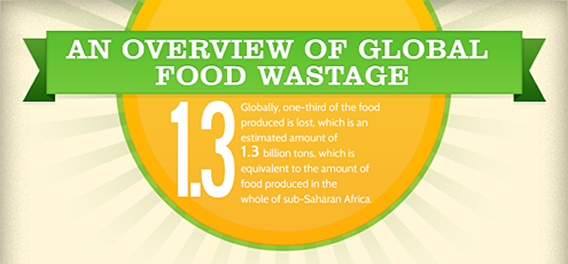The High Cost of Food Waste
Image: http://www.foodwastenews.com/ Where does food waste come from? All along the supply chain from "farm to fork": at the farm, during transport and storage, at stores and restaurants and finally from the consumer. How much is wasted? According to the Natural Resources Defense Council, approximately 40% of all edible foods (not including bones, peels and other inedible parts). Most is thrown out by consumers, primarily fresh foods. The U.S. Department of Agriculture says that a typical American throws out 40% of their fresh fish, 23% of eggs and 20% of milk. Citrus fruits and cherries top the list for fruits thrown away, and sweet potatoes, onions and greens are the most commonly wasted vegetables. Two thirds of this waste comes from not being used in time. The rest comes from cooking or serving too much, i.e., plate waste.
These estimates are just for the U.S. Mining Your Refrigerator Often the greatest waste occurs in the refrigerator. Burrow deep and assess what's hidden in crisper drawers and the "nether" regions of your fridge. Prevent spoilage by learning which veggies do well stored in plastic bags and which do better in paper or cloth bags. Prioritize the produce to be eaten first. Remember you can freeze or dry certain items in order to rescue them. Gather together what needs to be used, and concoct a delectable dish with these ingredients. If you need help, refer to a cookbook for your main ingredient and get ideas from that for combinations. Here's a recipe to get you started! Japanese-Style Broth with Millet “Dumplings” Leftover millet gets a refreshing update in this Japanese-inspired broth. Leftovers don’t have to mean lukewarm patties featuring all of the refrigerator’s contents covered in cheese. Instead, they can be a great way to cut down on mealtime labor, and you can still enjoy something tasty, fresh, and new! Broth 6 c. water or vegetable broth (I make mine out of leek tops, parsley stems, winter squash peelings and seeds, a handful of garlic cloves and veggie trimmings. I always add some thyme and bay leaf as well.) Millet “dumplings” 1 1/2 c cooked millet (try any other leftover cooked grain you have on hand!) Instructions: Place all of the ingredients for the broth together (the white miso will not dissolve immediately) in a stockpot over low heat, and heat to just below boiling. Hold it around this temperature for at least 20 minutes or as long as 2 hours. Meanwhile, knead together all of the “dumpling” ingredients. If the cooked millet is not moist enough to stick together, add some stock, hazelnut milk or nut butter of your choice (we use sunflower butter with no salt or sugar added). Using your hands, form the mixture like a cookie, in 3/4-inch balls, and lay them on a plate or cookie sheet. Just before serving, place the millet balls in a 350 degree F oven for 5-10 minutes, until center is heated through. Place 3 or 4 millet balls straight into bowls, and ladle hot broth over them, avoiding large seaweed pieces. If you want, you can strain the broth before you serve it. Enjoy! .
top | Newsletter Home | Article Index | Archive
|



